Geological Map of the Proclus Crater: A Study Case to Integrate Composition and Morpho-Stratigraphic Mapping on the Moon
Highlights
- Integrated geostratigraphic map permits us to discuss both the different morphologies and the compositional variation in Proclus crater, with specific geostratigraphic units.
- Two geostratigraphic units permit the definition of subunits highlighting a high variability of mineral chemistry and relative abundances on freshly exposed portions of the walls.
- The production of geostratigraphic maps permits the exploration of the geology within the crater, and a higher understanding from the map itself can be achieved in terms of target selection, exploration traverse definition, and evaluation of localized in situ resource utilization.
- Spectral units, and the retrieved mineralogical variation, seem to suggest the presence of magma traps during the plagioclase floating within the lunar primary crust formation, and constituting heterogeneous terrains within the Highland.
Abstract
1. Introduction
2. Data and Methods
2.1. LROC and LRO Images
2.2. M3 Data
2.3. Methods and Analytical Approach
2.3.1. Mapping Method for the Geomorphological Map
- (1)
- Geological contacts define the boundary of geologic units, that are surfaces characterized by the same characteristics, such as albedo/color, texture, and stratigraphic position. Contacts are classified as follows: certain, where the boundary between adjacent units is detected with confidence, and approximate, where it is not well defined.
- (2)
- Lineaments include the following: (i) crater rims, that define the crests of craters, (ii) fractures, that are breaks in the rocks due to tensile stresses by thermal contraction, (iii) strata, that are bedding planes parallel to each other, and (iv) terraces, that are relatively flat plains, offset by steep scarps facing the center of the crater. In the geological map, the terrace margins have been outlined.
2.3.2. Spectral Mapping and Definition of Mineralogy
- (1)
- Spectral mapping of the endmembers indicating SU using the Spectral Angle Mapper (SAM), considering a selection of endmembers from the M3 image on the basis of differences in absorption processes resulting in the image classification;
- (2)
- Mineralogical analysis of the average spectra of each SU via deconvolution using Gaussian modeling and comparison with laboratory spectral analogs.
Spectral Mapping
- (1)
- We applied the Purity Pixel Index (PPI, [17]), the PPI algorithm records the extreme pixels, counting the total number of times each pixel is marked as extreme, and we identified seven clusters. The PPI has been applied following the approach used in [16], where the PPI is applied on a Minimum Noise Fraction (MNF) transform to reduce the impact of image noise, transforming the data into a lower-dimensional subspace. To ensure that no spectral information was removed, spectra after the application of MNF are compared with original spectra (see [16] for more details).
- (2)
- Then looking into the variability of the clusters identified by the PPI and the first results of SAM at low acceptance angles (>0.1 radians), four other endmembers were added; the implemented endmembers resulted in a mixing of previously identified units, which are geographically distributed in significant clusters.
Mineralogical Analysis
2.3.3. Geostratigraphical Mapping

3. Results
3.1. Geomorphological Map
3.2. Spectral Map
3.3. Mineralogical Analysis
3.4. Geostratigraphic Map
- (1)
- Taluses are outlined with an inferred contact in the geomorphological map; however, spectral map allowed us to identify the extent of the deposits, since there is a different spectral behavior between incoherent collapsed material and in situ rock. So, we considered as reference the spectral units to outline the boundary of the units.
- (2)
- Talus cones were drawn following geomorphological contacts, since they are clearly visible in the MDIS mosaic, although they do not have a proper spectral counterpart.
- (3)
- The crater wall outcrops are distinguished in four different geostratigraphic units: w1, w2, w3, w4. No morphological difference has been distinguished on these units. So, we argued that the main differences are related to the composition of in situ rocks present in this area before the crater formation, and excavated by this event, as well as the material of the following mass waste.
4. Discussion
- (1)
- First, after the impact, we have the formation of the floor as well as of the ejecta characterized by materials with the predominance of two spectral units (SU5 and SU6). Those units show the lower reflectance (a part of small patches of SU4) and the most reduced spectral contrast (see Figure 5). SU5 shows a mineral assemblage of mafic phases (±plagioclase and spinels; see Section 3.3), and SU6 is almost featureless. The reduced and relatively low reflectance are compatible with the presence of material that could be characterized by different physical properties: (a) presence of crystals, small, embedded in amorphous matrix (e.g., here seen in smooth plains and ejecta [9,51]); (b) relative re-worked coarse mixing (e.g., here seen in portions of the talus and talus cones or in knobby terrains, e.g., [9,52]). Moreover, we cannot rule out that partially in this unit space, weathering could act longer in time than on the walls where mass wasting deposits allow the exposure of fresher material.
- (2)
- Few smooth deposits (sd) are identified by morphological point of view within talus and floor units, which, however, do not show specific association with SU among 5 and 6. Those small patches are likely mainly characterized by material that undergoes re-melting, and so they do not show well contrasted spectral signatures. Those patches are spectrally closer, or in between, to the SU5 and SU6. Moreover, the lower spatial resolution of the M3 image with respect to the LRO camera mosaics does not permit the assessment of enough pixels with spectra attributable only to the material characterizing the sd unit.
- (3)
- Large boulders fell down from the wall, are identified within the knobby terrains and on a talus, cone deposit on the northern side. They are dominated by mafic mineralogy (SU2 and SU3). In fact, they are spectrally recognizable from the surrounding since they result in less reworked material, permitting the detecting of the spectral signatures of the dominating pyroxene absorptions.
- (4)
- Later to the formation of the crater, wall underwent waste movement, which exposed fresher bedrocks. Thus, the most interesting evidence is on the upper portion of the walls, where four SUs are present, with the SU1 and SU2 covering almost completely this area (Figure 3 and Figure 4). Mainly SU1 is identified in the w1 unit on the northern part of the wall, whereas the SU2 covers the rest of the wall unit. A few small portions are interested by the exposure of assemblages with relevant clinopyroxene (by deconvolution, see Section 3.3) distributed on NE and locally on S and W sides (w3), and the appearance of an olivine spectrally dominated region (w4) on the SE. This unit (w4) shows a typical ultramafic mineral mixture, such as a mantle-like olivine and some opaque phases (possible oxides such as chromite or magnetite). MGM deconvolution (see in the result Section 3.3) identifies a strong correlation of the used Gaussian distributions to the olivine, with relatively high forsterite composition. Nevertheless, the missing third Gaussian as well as the evidence of a dark reflectance suggested that this unit is not monomineralic.
5. Conclusions
Author Contributions
Funding
Data Availability Statement
Acknowledgments
Conflicts of Interest
References
- Massironi, M.; Rossi, A.P.; Wright, J.; Zambon, F.; Poehler, C.; Giacomini, L.; Carli, C.; Ferrari, S.; Semenzato, A.; Luzzi, E.; et al. From morpho-stratigraphic to geo-stratigraphic units: The PLANMAP contribution. In Proceedings of the EGU General Assembly 2021, Online, 19–30 April 2021. EGU21-15675. [Google Scholar] [CrossRef]
- Semenzato, A.; Massironi, M.; Ferrari, S.; Galluzzi, V.; Rothery, D.A.; Pegg, D.L.; Pozzobon, R.; Marchi, S. An integrated geologic map of the Rembrandt basin, on Mercury, as a starting point for stratigraphic analysis. Remote Sens. 2020, 12, 3213. [Google Scholar] [CrossRef]
- Wright, J.; Zambon, F.; Carli, C.; Altieri, F.; Pöhler, C.M.; Rothery, D.A.; Van der Bogert, C.; Rossi, A.P.; Massironi, M.; Balme, M.; et al. A geostratigraphic map of the Rachmaninoff basin area: Integrating morphostratigraphic and spectral units on Mercury. Earth Space Sci. 2024, 11, e2023EA003258. [Google Scholar] [CrossRef]
- Tognon, G.; Zambon, F.; Carli, C.; Massironi, M.; Giacomini, L.; Pozzobon, R.; Salari, G.; Tosi, F.; Combe, J.-P.; Fonte, S. Integrated spectral and compositional analysis for the lunar Tsiolkovskiy crater. J. Geophys. Res. Planets 2024, 129, e2023JE008272. [Google Scholar] [CrossRef]
- Giacomini, L.; Carli, C.; Sgavetti, M.; Massironi, M. Spectral analysis and geological mapping of Daedalia Planum lava field (Mars) using OMEGA data. Icarus 2012, 220, 679–693. [Google Scholar] [CrossRef]
- El-Baz, F.; Worden, A.M. Apollo 15 Preliminary Science Report 25-1–25-25; NASA SP-289; US Government Printing Office: Washington, DC, USA, 1972. Available online: https://www.nasa.gov/wp-content/uploads/static/history/alsj/a15/as15psr.pdf (accessed on 8 December 1971).
- Pieters, C.M. Composition of the lunar highland crust from near-infrared spectroscopy. Rev. Geophys. 1986, 24, 557–578. [Google Scholar] [CrossRef]
- Blewett, D.T.; Hawke, P.G.; Lucey, P.G.; Spudis, P.D. A spectral survey of the Crisium region of the Moon. Geophys. Res. Let. 1994, 22, 3059–3062. [Google Scholar] [CrossRef]
- Schonfeld, E. High spatial resolution Mg/Al maps of Wester Crisium and Sulpicius Gallus regions. Proc. Lunar Planet. Sci. Conf. 1981, 12, 809–816. [Google Scholar]
- Ohtake, M.; Matsunaga, T.; Haruyama, J.; Yokota, Y.; Morota, T.; Honda, C.; Ogawa, Y.; Torii, M.; Miyamoto, H.; Arai, T.; et al. The global distribution of pure anorthosite on the Moon. Nature 2009, 461, 236–240. [Google Scholar] [CrossRef]
- Donaldson Hanna, K.L.; Cheek, L.C.; Pieters, C.M.; Mustard, J.F.; Greenhagen, B.T.; Thomas, I.R.; Bowles, N.E. Global assessment of pure crystalline plagioclase across the Moon and implications for the evolution of the primary crust. J. Geophys. Res. Planets 2014, 119, 1516–1545. [Google Scholar] [CrossRef]
- Klem, S.M.; Henriksen, M.R.; Stopar, J.; Boyd, A.; Robinson, M.S. Controlled LROC Narrow Angle Camera High Resolution Mosaics. In Proceedings of the Lunar and Planetary Science Conference, The Woodlands, TX, USA, 17–21 March 2014; Volume 45. [Google Scholar]
- Pieters, C.M.; Boardman, J.; Buratti, B.; Chatterjee, A.; Clark, R.; Glavich, T.; Green, R.; Head, J., III; Isaacson, P.; Malaret, E.; et al. The Moon Mineralogy Mapper (M3) on Chandrayaan-1. Curr. Sci. 2009, 96, 500–505. [Google Scholar]
- Kruse, F.A.; Lefkoff, A.B.; Boardman, J.W.; Heidebrecht, K.B.; Shapiro, A.T.; Barloon, P.J.; Goetz, A.F.H. The Spectral Image Processing System (SIPS)—Interactive Visualization and Analysis of Imaging spectrometer Data. Remote Sens. Environ. 1993, 44, 145–163. [Google Scholar] [CrossRef]
- Kodikara, G.R.L.; Champati ray, P.K.; Chauhan, P.; Chatterjee, R.S. Spectral mapping of morphological features on the moon with MGM and SAM. Int. J. Appl. Earth Obs. Geoinf. 2016, 44, 31–41. [Google Scholar] [CrossRef]
- Serventi, G.; Carli, C.; Altieri, F.; Geminale, A.; Sgavetti, M. Spectral classification and MGM-based mineralogical characterization of hydrated phases: The Nili Fossae case, Mars. Planet. Space Sci. 2021, 209, 105361. [Google Scholar] [CrossRef]
- Boardman, J.W. Automating spectral unmixing of AVIRIS data using convex geometry concepts. In Summaries of the 4th Annual JPL Airborne Geoscience Workshop; NASA: Washington, DC, USA, 1993; pp. 11–14. [Google Scholar]
- Clark, R.N.; Roush, T.L. Reflectance Spectroscopy: Quantitative Analysis Techniques for Remote Sensing Applications. J. Geophys. Res. 1984, 89, 6329–6340. [Google Scholar] [CrossRef]
- Sunshine, J.M.; Pieters, C.M.; Pratt, F.P. Deconvolution of mineral absorption bands: An improved approach. J. Geophys. Res. 1990, 95, 6955–6966. [Google Scholar] [CrossRef]
- Sunshine, J.M.; Pieters, C.M. Estimating modal abundances from the spectra of natural and laboratory pyroxene mixtures using the Modified Gaussian Model. J. Geophys. Res. 1993, 98, 9075–9087. [Google Scholar] [CrossRef]
- Sunshine, J.M.; Pieters, C.M. Determining the composition of olivine from reflectance spectroscopy. J. Geophys. Res. 1998, 103, 13675–13688. [Google Scholar] [CrossRef]
- Klima, R.L.; Pieters, C.M.; Dyar, D.M. Spectroscopy of synthetic Mg-Fe pyroxenes I: Spin-allowed and spin-forbidden crystal field bands in the visible and near-infrared. Meteoritcs Planet. Sci. 2007, 42, 235–253. [Google Scholar] [CrossRef]
- Klima, R.L.; Dyar, D.M.; Pieters, C.M. Near-infrared spectra of clinoyroxenes: Effect of calcium content and crystal structure. Meteoritcs Planet. Sci. 2011, 46, 379–395. [Google Scholar] [CrossRef]
- Clenet, H.; Pinet, P.; Daydou, Y.; Heuripeau, F.; Rosemberg, C.; Baratoux, D.; Chevrel, S.D. A new systematic approach using the modified Gaussian model: Insight for the characterization of olivine-pyroxene mixtures and minerals chemicals compositions. Icarus 2011, 213, 404–422. [Google Scholar] [CrossRef]
- Cheek, L.C.; Pieters, C.M. Reflectance spectroscopy of plagioclase-dominated mineral mixtures: Implication for characterizing lunar anorthosites remotely. Am. Min. 2014, 99, 1871–1892. [Google Scholar] [CrossRef]
- Serventi, G.; Carli, C.; Sgavetti, M. Spectral variability of plagioclase-mafic mixtures (3): Quantitatively analysis appling the MGM algorithm. Icarus 2015, 254, 34–55. [Google Scholar] [CrossRef]
- Pinet, P.C.; Daydou, Y.; Chevrel, S.D. Olivine composition and reflectance spectroscopy relationship revisited from advanced MGM deconvolution based on synthetic and natural samples. Icarus 2022, 373, 114765. [Google Scholar] [CrossRef]
- Pinet, P.C.; Chevrel, S.D.; Daydou, Y.; Carli, C.; Bruschini, E.; Cuppone, T.; Pratesi, G. Advanced mgm deconvolution on powder versus slab of olivine natural samples: A test with nwa 5400. In Proceedings of the 10th European Lunar Symposium, Online, 24–26 May 2022; pp. 103–104. [Google Scholar]
- Clenet, H.; Pinet, P.C.; Ceuleneer, G.; Daydou, Y.; Heuripeau, F.; Rosemberg, C.; Bibring, J.-P.; Bellucci, G.; Altieri, F.; Gondet, B. A systematic mapping procedure based on the modified gaussian model to characterize magmatic units from olivine/pyroxenes mixtures: Application to the Syrtis major volcanic shield on mars. J. Geophys. Res. Planets 2013, 118, 1632–1655. [Google Scholar] [CrossRef]
- Serventi, G.; Carli, C.; Sgavetti, M.; Ciarniello, M.; Capaccioni, F.; Pedrazzi, G. Spectral variability of plagioclase-mafic mixtures (1): Effects of chemistry and modal abundance in reflectance spectra of rocks and mineral mixtures. Icarus 2013, 226, 282–298. [Google Scholar] [CrossRef]
- Serventi, G.; Carli, C.; Sgavetti, M. Deconvolution of mixtures with high plagioclase content for the remote interpretation of lunar plagioclase-rich regions. Icarus 2016, 272, 1–15. [Google Scholar] [CrossRef]
- Zambon, F.; Carli, C.; Wright, J.; Rothery, D.A.; Altieri, F.; Massironi, M.; Capaccioni, F.; Cremonese, G. Spectral units analysis of quadrangle H05-Hokusai on Mercury. J. Geophys. Res. Planets 2022, 127, e2021JE006918. [Google Scholar] [CrossRef]
- Denevi, B.W.; Noble, S.K.; Christoffersen, R.; Thompson, M.S.; Glotch, T.D.; Blewett, D.T.; Garrick-Bethell, I.; Gillis-Davis, J.J.; Greenhagen, B.T.; Hendrix, A.R.; et al. Space Weathering At The Moon. Rev. Miner. Geochem. 2023, 89, 611–650. [Google Scholar] [CrossRef]
- Pieters, C.M.; Fischer, E.M.; Rode, O.; Basu, A. Optical effects of space weathering: The role of the finest fraction. J. Geophys. Res. 1993, 98, 20817–20824. [Google Scholar] [CrossRef]
- Hiroi, T.; Kaiden, H.; Misawa, K.; Kojima, H.; Uemoto, K.; Ohtake, M.; Arai, T.; Sasaki, S.; Takeda, H.; Nyquist, L.E.; et al. Diversity in the visible-NIR absorption band characteristics of lunar and asteroidal plagioclase. Lunar. Planet. Sci. 2012, 43, 1168. [Google Scholar]
- Burns, R.G. Mineralogical Applications Of Crystal Field Theory; Cambridge University Press: Cambridge, UK, 1993; p. 551. [Google Scholar]
- Serventi, G.; Carli, C. The role of very fine particle sizes in the reflectance spectroscopy of plagioclase-bearing mixtures: New understanding for the interpretation of the finest sizes of the lunar regolith. Icarus 2017, 293, 157–171. [Google Scholar] [CrossRef]
- Carli, C.; Serventi, G.; Sgavetti, M. VNIR spectral variability of the igneous stratified Stillwater Complex: A tool to map lunar highlands. Am. Mineral. 2014, 99, 1834–1848. [Google Scholar] [CrossRef]
- Isaacson, P.J.; Pieters, C.M. Deconvolution of lunar olivine reflectance spectra: Implication for remote compositional assessment. Icarus 2010, 21, 8–13. [Google Scholar] [CrossRef]
- Pompilio, L.; Sgavetti, M.; Pedrazzi, G. Visible and near-infrared reflectance spectroscopy of pyroxene-bearing rocks: New constraints for understanding planetary surface compositions. J. Geophys. Res. Planets 2007, 112, E01004. [Google Scholar] [CrossRef]
- Gross, J.; Isaacson, P.J.; Treiman, A.H.; Le, L.; Gorman, J.K. Spinel-rich lithologies in the lunar highland crust: Linking lunar samples with crystallization experiments and remote sensing. Am. Mineral. 2014, 99, 1849–1859. [Google Scholar] [CrossRef]
- Pieters, C.M.; Besse, S.; Boardman, J.; Buratti, B.; Cheek, L.; Clark, R.N.; Combe, J.P.; Dhingra, D.; Goswami, J.N.; Green, R.O.; et al. Mg-spinel lithology: A new rock type on the lunar farside. JGR 2011, 116, E00G08. [Google Scholar] [CrossRef]
- Elkins-Tanton, L.T.; Burgess, S.; Yin, Q.Z. The lunar magma ocean: Reconciling the solidification process with lunar petrology and geochronology. Earth Planet. Sci. Lett. 2011, 304, 326–336. [Google Scholar] [CrossRef]
- Blewett, D.T.; Lucey, P.G.; Hawke, B.R. Clementine images of the lunar sample-return stations: Refinement of FeO and TiO2 mapping techniques. J. Geophys. Res. 1997, 102, 16319–16325. [Google Scholar] [CrossRef]
- Yan, B.; Wang, R.; Gan, F.; Wang, Z. Minerals mapping of the lunar surface with Clementine UVVIS/NIR data based on spectra unmixing method and Hapke model. Icarus 2010, 208, 11–19. [Google Scholar] [CrossRef]
- Lucey, P.G.; Blewett, D.T.; Hawke, B.R. Mapping the FeO and TiO2 content of the lunar surface with multispectral imagery. J. Geophys. Res. 1998, 103, 3679–3699. [Google Scholar] [CrossRef]
- Paul, G.; Lucey, P.G. Mineral maps of the Moon. Geophys. Res. Lett. 2004, 31, L08701. [Google Scholar] [CrossRef]
- Cheek, L.C.; Pieters, C.M. Variations in anorthosite purity at Tsiolkovsky crater on the Moon. Lunar. Planet. Sci. 2012, 43, 2624. [Google Scholar]
- Yamamoto, S. Massive layer of pure anorthosite on the Moon. Geophys. Res. Lett. 2012, 39, L13201. [Google Scholar] [CrossRef]
- Scholten, F.; Oberst, J.; Matz, K.-D.; Roatsch, T.; Wählisch, M.; Speyerer, E.J.; Robinson, M.S. GLD100:The near-global lunar 100 m raster DTM from LROC WAC stereo image data. J. Geophys. Res. 2012, 117, E00H17. [Google Scholar] [CrossRef]
- Scudder, N.A.; Horgan, B.H.N.; Rampe, E.B.; Smith, R.J.; Rutledge, A.M. The effects of magmatic evolution, crystallinity, and microtexture on the visible/near-infrared and thermal-infrared spectra of volcanic rocks. Icarus 2021, 359, 114344. [Google Scholar] [CrossRef]
- Carli, C.; Sgavetti, M. Spectral characteristics of rocks: Effects of composition and texture and implications for the interpretation of planet surface compositions. Icarus 2011, 211, 1034–1048. [Google Scholar] [CrossRef]
- Bruschini, E.; Carli, C.; Tosi, F. Mapping the Spectral and Mineralogical Variability of Lunar Breccia Meteorite NWA 13859 by VNIR Reflectance Spectroscopy. Minerals 2023, 13, 1000. [Google Scholar] [CrossRef]
- Carli, C.; Ferrari, S.; Cuppone, T.; Pratesi, G.; Bruschini, E.; Stephant, A.; Baschetti, B.; Zambon, F.; Massironi, M.; Tosi, F. Hyperspectral VNIR imaging of lunar meteorites. In Proceedings of the European Lunar Symposium 2023, Padua, Italy, 27–29 June 2023; pp. 52–53. [Google Scholar]
- Carli, C.; Tosi, F.; Jadid, F.-E.; Chennaoui, H. Reflectance properties of North West Africa 13951 and 16372. In Proceedings of the European Lunar Symposium 2025, Munster, Germany, 22–27 June 2025. [Google Scholar] [CrossRef]
- Lucey, P.; Korotev, R.L.; Gillis, J.J.; Taylor, L.A.; Lawrence, D.; Campbell, B.A.; Elphic, R.; Feldman, B.; Hood, L.L.; Hunten, D.; et al. Understanding the lunar surface and space–moon interactions. Rev. Mineral. Geochem. 2006, 60, 83–219. [Google Scholar] [CrossRef]
- Yamamoto, S.; Nakamura, R.; Matsunaga, T.; Ogawa, Y.; Ishihara, Y.; Morota, T.; Hirata, N.; Ohtake, M.; Hiroi, T.; Yokota, Y.; et al. Possible mantle origin of olivine around lunar impact basins detected by SELENE. Nat. Geosci. 2010, 3, 533–536. [Google Scholar] [CrossRef]
- Dhingra, D.; Pieters, C.M.; Head, J.H. Multiple origins for olivine at Copernicus crater. Earth and planet. Sci. Lett. 2015, 420, 95–101. [Google Scholar] [CrossRef]
- Collin, L.; Michaut, C.; Labrosse, S.; Bourdon, B. Thermal evolution of the lunar magma ocean. Earth Planet. Sci. Lett. 2024, 648, 119109. [Google Scholar] [CrossRef]
- Dauphas, N.; Zhang, Z.J.; Chen, X.; Barboni, M.; Szymanowski, D.; Schoene, B.; Leya, I.; McKeegan, K.D. Completion of lunar magma ocean solidification at 4.43 Ga. Proc. Natl. Acad. Sci. USA 2025, 122, e2413802121. [Google Scholar] [CrossRef]
- Zhang, Y.-W.; Sheng, S.-Z.; Wang, S.-J.; Li, Q.-L.; Hua, J.-X.; Li, S.; Li, X.-H. Lead isotopic evidence for an old and rapid lunar magma ocean. Sci. Adv. 2025, 11, eadu5111. [Google Scholar] [CrossRef]
- Neeraja, C.R.; Arivazhagan, S.; Abishek, P. Decoding the Apollo basin: Insights into volcanism, compositional diversity and crustal evolution. Planet. Space Sci. 2025, 268, 106204. [Google Scholar] [CrossRef]
- Arivazhagan, S.; Karthi, A. Compositional and chronological characterization of mare crisium using chandrayaan-1 and LROC-WAC data. Planet. Space Sci. 2018, 161, 41–56. [Google Scholar] [CrossRef]

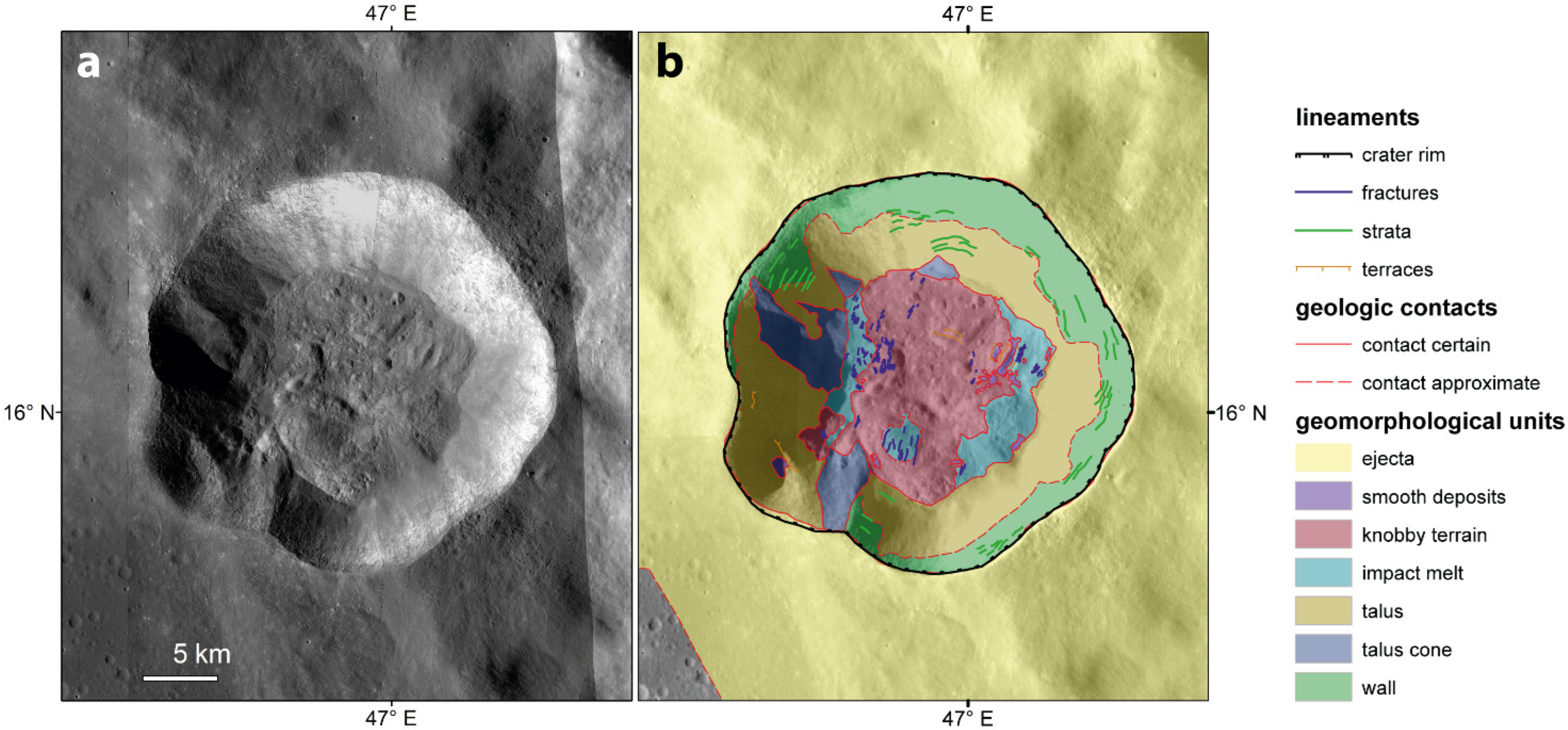
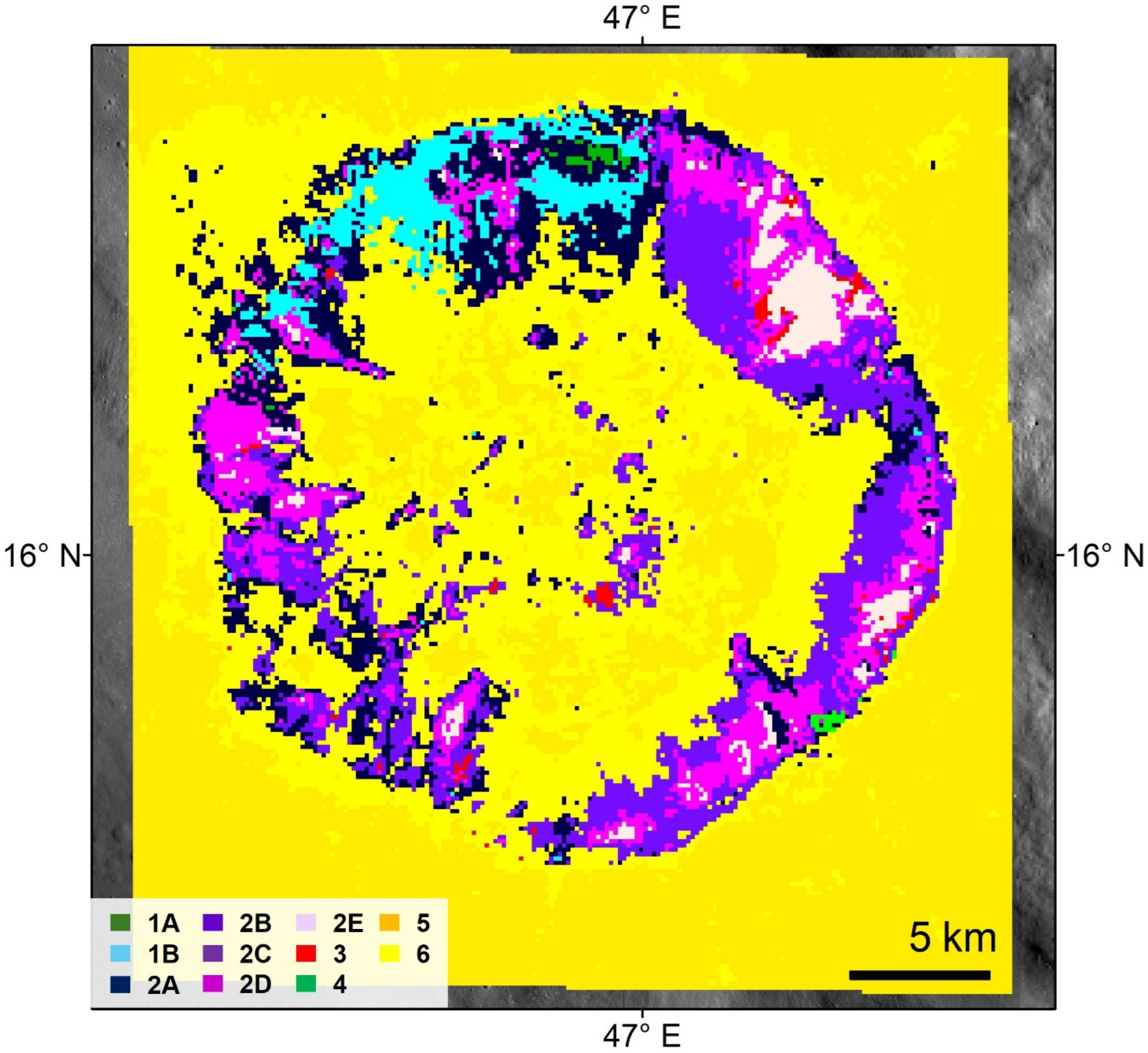
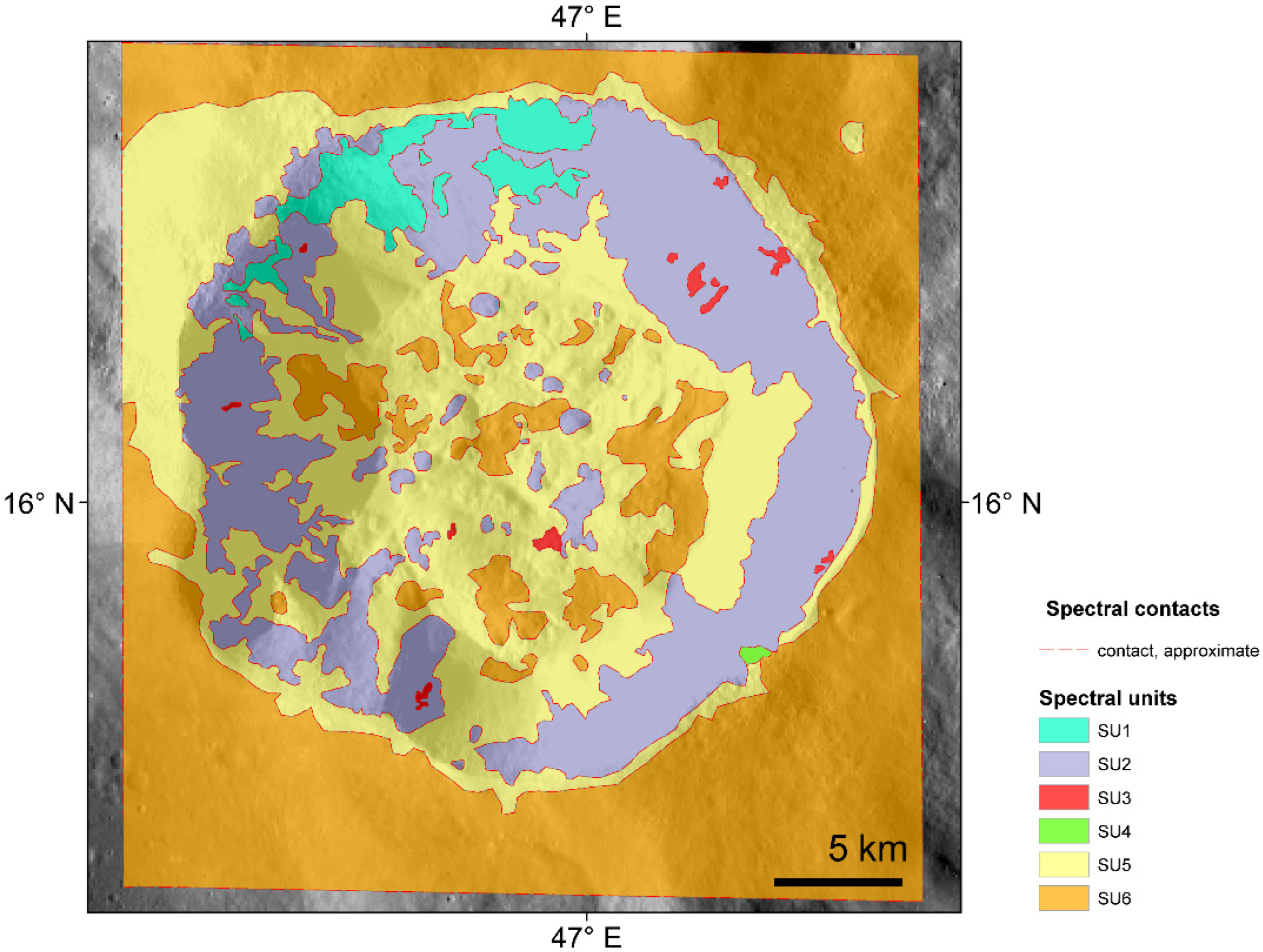
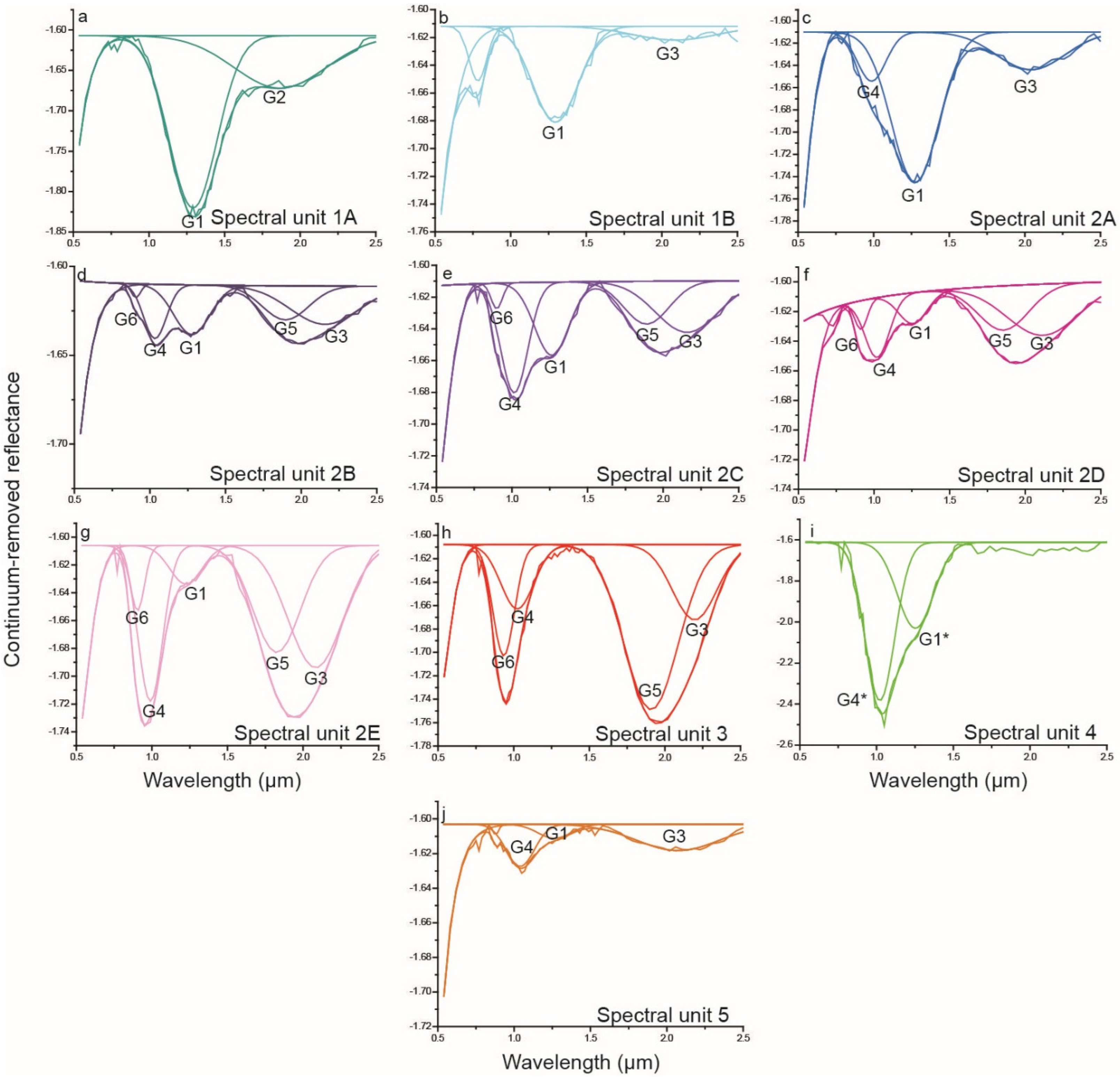
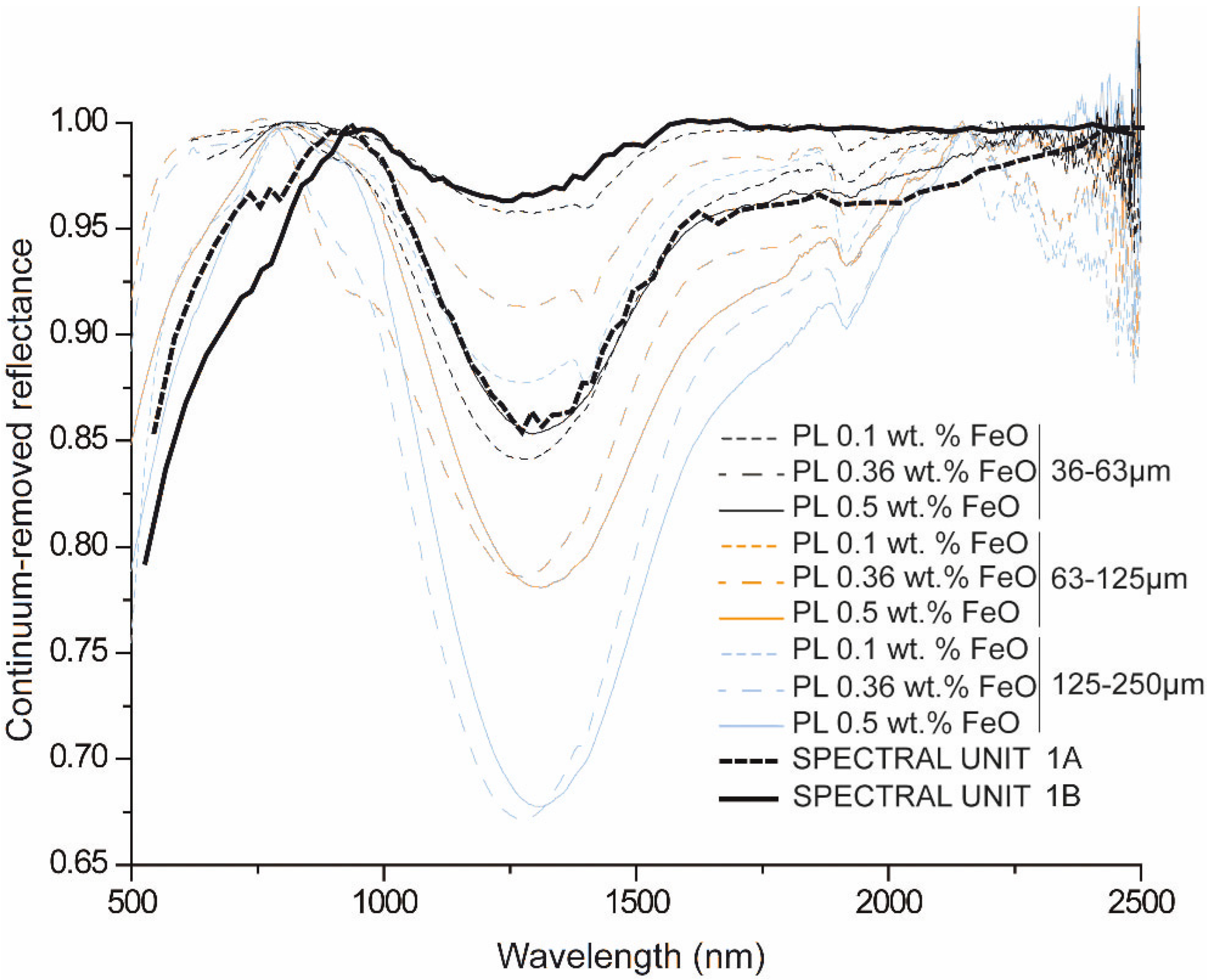
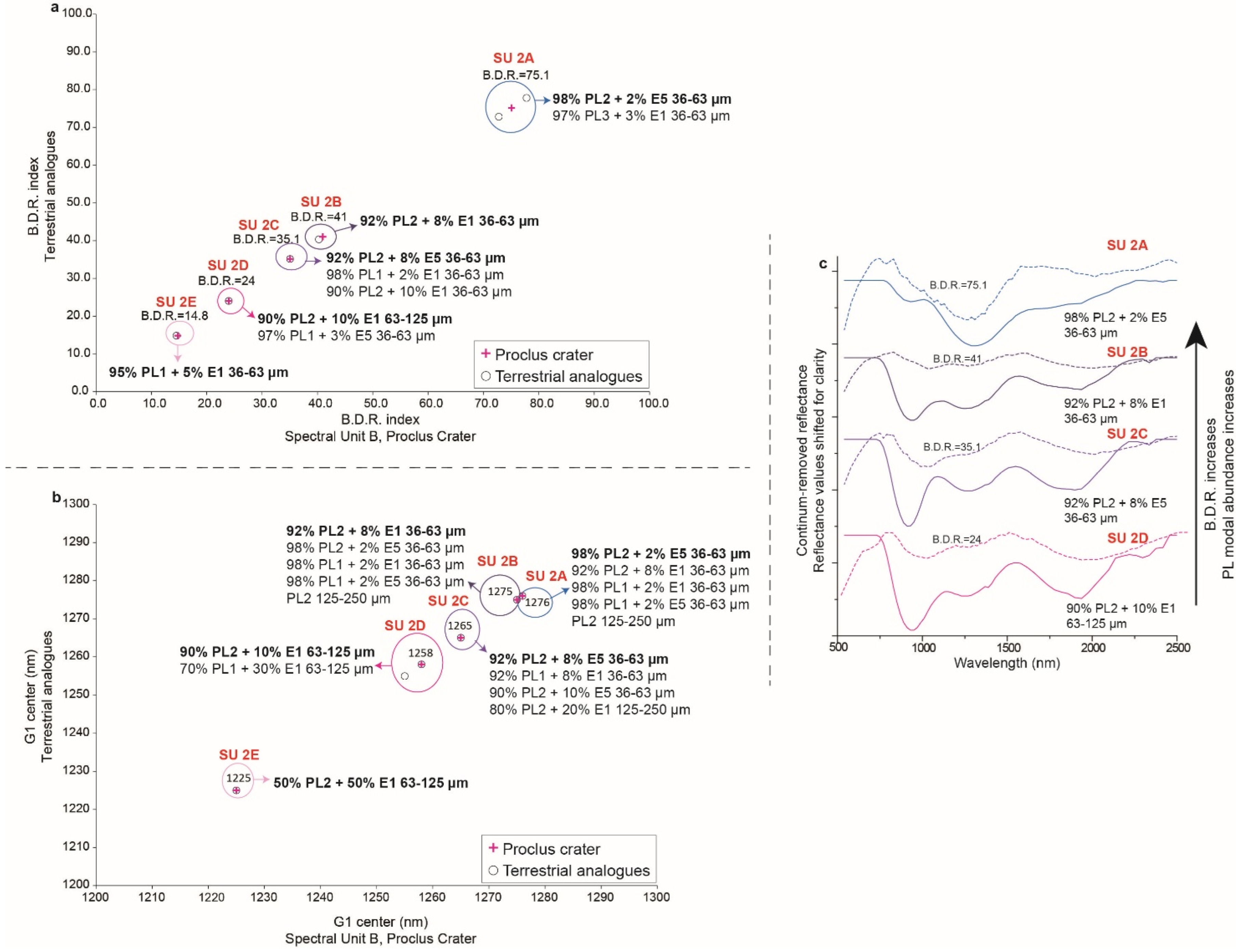


| NAC_ROI_PROCLUS_LOA_E161N0468: | Proclus Mosaic (Western Half): |
|---|---|
| M1249219437R | m104211600re |
| M1249219437L | m104211600le |
| M1249226474R | m104204440re |
| M1249226474L | m104204440le |
| M1249233510R | |
| M1249233510L | |
| M1249240546R | |
| M1249240546L |
| Gaussian | B.C. (nm) | Band Attribution |
|---|---|---|
| G1 | 1200–1300 | Fe2+ in Plagioclase on substitution of Ca2+ |
| G2 | 1800 | Fe2+ in Plagioclase on substitution of Ca2+ |
| G6, G4 | 900–1020 | Fe2+ in M2 and M1 site on pyroxene (ortho-, clino-) |
| G5, G3 | 1850–2300 | Fe2+ in M2 site on pyroxene (ortho-, clino-) + Spinel |
| G4*, G1* | 990–1250 | Fe2+ in M2 and M1 site on olivine |
Disclaimer/Publisher’s Note: The statements, opinions and data contained in all publications are solely those of the individual author(s) and contributor(s) and not of MDPI and/or the editor(s). MDPI and/or the editor(s) disclaim responsibility for any injury to people or property resulting from any ideas, methods, instructions or products referred to in the content. |
© 2025 by the authors. Licensee MDPI, Basel, Switzerland. This article is an open access article distributed under the terms and conditions of the Creative Commons Attribution (CC BY) license (https://creativecommons.org/licenses/by/4.0/).
Share and Cite
Carli, C.; Giacomini, L.; Serventi, G.; Sgavetti, M. Geological Map of the Proclus Crater: A Study Case to Integrate Composition and Morpho-Stratigraphic Mapping on the Moon. Remote Sens. 2025, 17, 3786. https://doi.org/10.3390/rs17233786
Carli C, Giacomini L, Serventi G, Sgavetti M. Geological Map of the Proclus Crater: A Study Case to Integrate Composition and Morpho-Stratigraphic Mapping on the Moon. Remote Sensing. 2025; 17(23):3786. https://doi.org/10.3390/rs17233786
Chicago/Turabian StyleCarli, Cristian, Lorenza Giacomini, Giovanna Serventi, and Maria Sgavetti. 2025. "Geological Map of the Proclus Crater: A Study Case to Integrate Composition and Morpho-Stratigraphic Mapping on the Moon" Remote Sensing 17, no. 23: 3786. https://doi.org/10.3390/rs17233786
APA StyleCarli, C., Giacomini, L., Serventi, G., & Sgavetti, M. (2025). Geological Map of the Proclus Crater: A Study Case to Integrate Composition and Morpho-Stratigraphic Mapping on the Moon. Remote Sensing, 17(23), 3786. https://doi.org/10.3390/rs17233786








